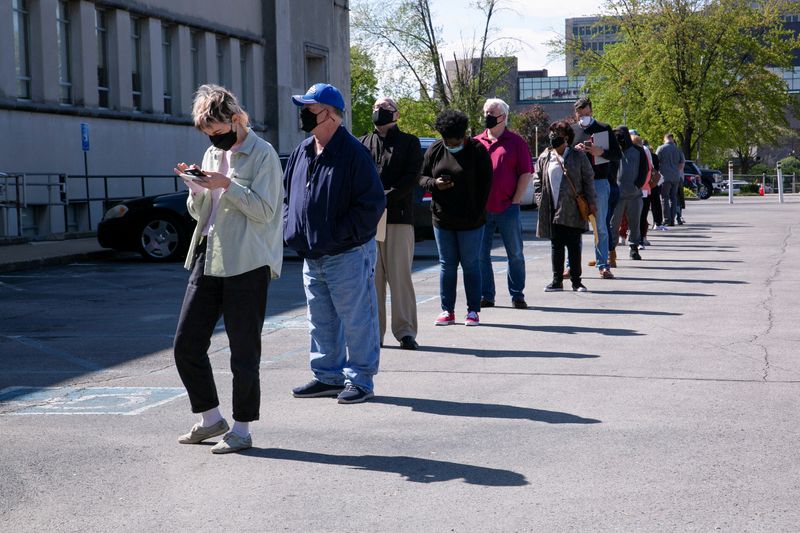
FILE PHOTO: People line up outside a newly reopened career center for in-person appointments in Louisville, U.S., April 15, 2021. REUTERS/Amira Karaoud
February 2, 2022
By Lucia Mutikani
WASHINGTON (Reuters) -U.S. private payrolls fell for the first time in a year in January as soaring COVID-19 infections disrupted business operations, raising the risk of a sharp decline in employment that would deal a temporary setback to the labor market.
Private payrolls decreased by 301,000 jobs last month after increasing by 776,000 in December, the ADP National Employment report showed on Wednesday. That was the first drop in private payrolls since December 2020. Economists polled by Reuters had forecast private payrolls would increase by 207,000 jobs.
The broad decline in private payrolls was led by the leisure and hospitality sector, with 154,000 job losses. Trade, transportation and utilities shed 62,000 jobs. Construction lost 10,000 jobs and manufacturing employment decreased by 21,000.
“The labor market recovery took a step back at the start of 2022 due to the effect of the Omicron variant and its significant, though likely temporary, impact to job growth,” said Nela Richardson, the ADP’s chief economist.
The ADP report is jointly developed with Moody’s Analytics and was published ahead of the release on Friday of the Labor Department’s more comprehensive and closely watched employment report for January. It has, however, a poor record predicting the private payrolls count in the department’s Bureau of Labor Statistics employment report because of methodology differences.
The ADP report counts all active workers as employed regardless of whether they are paid or not during the survey week. In contrast, people who are out sick or in quarantine and do not get paid during the payrolls survey period are counted as unemployed in the BLS survey of establishments even if they still have a job with their companies.
The decline in private payrolls in the ADP report suggests that some workers were laid off because of a lack of business as COVID-19 infections, driven by the Omicron variant, slammed demand. Businesses were also probably unable to find workers, with so many people at home because of soaring infections.
MILLIONS AT HOME
According to the U.S. Census Bureau’s Household Pulse Survey published in mid-January, 8.8 million people reported not being at work because of coronavirus-related reasons between Dec. 29 and Jan. 10. This has left some economists bracing for a decline on Friday in the nonfarm payrolls count for January.
According to a Reuters survey of economists, nonfarm payrolls likely increased by 150,000 jobs in January. Estimates range from a decrease of 400,000 to an increase of 385,000. The economy created 199,000 jobs in December, the fewest in a year.
The White House has been frantically trying to prepare the nation for a disappointing nonfarm payrolls number, with several officials offering a preview of the report.
“I think the key point, from our perspective, is the underlying strength of the economy,” Jared Bernstein, a member of the White House’s Council of Economic Advisers, told CNN this week. “The underlying strength of the job market is ongoing because, as we have seen, the caseloads are turning over.”
The United States is reporting an average of 461,097 new COVID-19 infections a day, sharply down from the more than 700,000 in mid-January, according to a Reuters analysis of official data.
Demand for labor is strong, with fewer workers available. There were 10.9 million job openings https://www.reuters.com/business/us-job-openings-rise-january-layoffs-decrease-2021-03-11 at the end of December.
First-time applications for unemployment benefits have retreated from a three-month high as the Omicron wave subsides.
(Reporting by Lucia MutikaniEditing by Chizu Nomiyama and Paul Simao)

